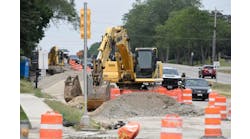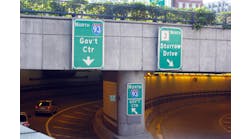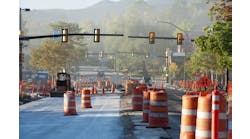For years, the BNSF railroad track in Frisco, Texas, has been a line of demarcation.
Most commercial development is east of the tracks; everything to the west is largely residential. But a new six-lane thoroughfare is about to break through that barrier, spreading increased mobility and the potential for economic development throughout this rapidly growing Dallas suburb.
Stonebrook Parkway, one of the city’s major east-west arterials, was started by a developer in 1998 but was never finished. A 3,800-linear-ft mid-section of the parkway, which would cross wetlands, leap over a creek and intersect with a busy BNSF mainline, was left undone because of the difficult conditions and development patterns. By 2006, Frisco’s growth necessitated its completion, and the city began work.
Part of the comprehensive
The city’s three existing east-west routes were bulging with motorists, many driving to and from the North Dallas Tollway, a major north-south route in the Dallas metro area. Inserting the missing piece of the parkway would give citizens a fourth option and relieve the overtaxed arterials.
“Frisco is one of the fastest-growing cities in the country,” said Mayor Maher Maso. “As a main east-west connector, the parkway will benefit commutes throughout the city.”
The new artery—capable of handling 36,000 to 60,000 vehicles per day—is part of Frisco’s comprehensive development plan. It will reduce congestion significantly, which is critical if Frisco is to preserve its quality of life and realize its full economic potential.
“Frisco isn’t even half built out yet. We have major developments in the works,” Maso said. “Stonebrook will provide the added mobility new companies seek and serve as a conduit for further economic development.”
Estimated at $23 million, the Stonebrook Parkway project is funded by city of Frisco bonds, Denton County bonds and North Central Texas Council of Government regional toll revenue. The project, now in its sixth year due to multiple complexities, includes:
- A 3,800-linear-ft, six-lane major thoroughfare;
- A U.S. Army Corps of Engineers 404 Individual Permit for wetland impact;
- Twin bridges over a creek;
- Relocation of a creek tributary into a 1,700-ft box culvert;
- A temporary railroad shoofly;
- A 195-ft, four-span railroad bridge; and
- Removal and replacement of a railroad trestle with four concrete box culverts.
“Alone, any one of those elements could provide a significant challenge, but combined, they have made this roadway one of the most complex projects the city has undertaken,” said Elizabeth Metting, assistant director and city engineer.
Working around
Stonebrook Parkway became a two-phase project in 2010 when a Christian academy requested an access road from the proposed alignment. The private campus was building a new high school. It was scheduled to open in January 2012.
According to city development requirements, the access road had to go in, but the city could not budge. It was awaiting a U.S. Corps of Engineers 404 Individual Permit for wetland mitigation along the parkway’s alignment. Processing could take two years.
In need of a solution, city officials turned to their project engineer of record, HNTB Corp.
HNTB recommended dividing the project into phases. Phase one, the portion of the project that could be completed while the 404 permit was pending, included the first 1,800 linear ft of the parkway from Legacy Drive east to just beyond the new access road, Fighting Eagles Lane.
“HNTB helped us assure the Corps that this earlier-than-planned work did not encroach on the environmentally sensitive areas,” Metting said.
Phase one was completed in November 2011, two months before the first bell rang welcoming the students to their new school.
“Seeing the constructed portion is very satisfying, and it gives us that much more motivation going into the second, more difficult phase,” Metting said.
Scheduled to start construction in fall 2012, phase two will continue the new section of Stonebrook Parkway east from Fighting Eagles Lane to the existing parkway some 2,000 ft away. For this segment to be completed, it will have to bisect an active BNSF rail line.
In 2000, HNTB presented city officials with three build alternatives for crossing this long-standing north-south barrier:
1. An at-grade crossing. An at-grade crossing at a busy mainline could cause significant traffic backups and potentially delay emergency vehicles. City officials also were concerned about the increased risk of accidents that at-grade crossings pose. Those concerns—coupled with the higher operational and maintenance costs associated with an at-grade railroad crossing—eliminated this option.
2. A bridge over the railroad. The elevation necessary to clear the rail line would lift the bridge 50 ft above adjacent neighborhoods. Residents strongly objected. Moreover, the bridge would reduce neighborhood access to the proposed thoroughfare, which negated one of the project’s primary objectives. And, because of the bridge’s elevation, noise and ice would be problems. Safety concerns and maintenance costs strengthened the argument against this alternative, and soon it was out, too.
3. An underpass. Instead of flying the parkway over the mainline, what if the city slid the parkway under it? This alternative still required building a bridge—but one that would carry rail traffic, not vehicles, and it would be constructed from the top down. For construction crews, the top-down approach would be safer and, for the city of Frisco, faster than conventional erection methods. Other benefits included:
- Lower noise levels than the other build alternatives;
- Improved accessibility of properties adjacent to the proposed roadway;
- Lower maintenance costs than the other build options as the bridge would be shorter and no railroad-crossing warning devices would
- be needed;
- Reliable travel times for emergency vehicles; and
- Safer driving conditions in
- winter weather.
The city had its preferred alternative.
Focused on four
While the underpass alternative met the city’s requirements, it would come with a unique set of challenges:
1. Diverting rail traffic. BNSF trains ran 24/7, and they would need to maintain that rigorous schedule throughout construction of the mainline bridge. To accommodate the railroad, HNTB designed a 2,000-ft shoofly, or detour, to be constructed just 30 ft east of the existing mainline. Trains, rerouted to the slender curve, could barrel by the construction site at normal speeds.
“It’s an innovative way to keep the trains moving and our project on track,” Metting said. “Plus, as it turns out, routing Stonebrook Parkway under the railroad will be less expensive than flying it over the railroad.”
Once rail traffic is switched to the shoofly, work can begin on the mainline bridge.
2. Building a rail bridge from the top down. HNTB had successfully used the top-down construction method before in previous projects along the same BNSF mainline. It was a proven approach.
To build the railroad bridge, crews will drill shafts into the earth, dig out the tops of the shafts, add the pier caps, place the I-beams and attach the deck. (Temporary vertical shoring at the bents will protect the shoofly during construction.) At this point, the bridge will be buried in earth up to its deck, which will rest at railroad grade.
Next, crews will excavate the bridge to reveal the entire structure, similar to a sculptor who sees a figure in a slab of clay and carves away the excess to free the image. When the excavation is complete, a new 195-ft, four-span bridge with more than an 18-ft clearance will straddle the proposed parkway alignment.
3. Removing a railroad trestle. Before any of that work can happen, though, crews will direct their attention to a railroad trestle near the south end of the shoofly. Part of the agreement with BNSF stipulates that this trestle will be replaced with four reinforced-concrete box culverts. These culverts must go in first—even before the trestle is removed—because the shoofly will be built over them. The culverts’ installation kicks off the entire construction sequence of the BNSF mainline crossing.
After the culverts have been installed, the shoofly can be built. Once trains are switched to the shoofly, the trestle can be removed and the contractor can fill the cavity with dirt. The railroad will put the ballast, railroad ties and rail back, and traffic will resume on the mainline.
4. Sequencing construction. Determining the order in which each task at the BNSF mainline crossing would be executed was one of the most challenging design aspects of this two-phase project. One incorrectly timed event would have a rolling effect across the length of the shoofly, and the multimillion-dollar project would be knocked off its trajectory.
After hours of planning and reviews by a construction expert, a structural expert and the city, HNTB arrived at the following sequence:
- Construct a new gas main to be located south of the proposed parkway;
- Install new concrete culverts, including upstream and downstream headwalls under the existing trestle bridge;
- Construct temporary shoring walls at the Stonebrook Bridge and at the new culvert location;
- Construct embankment and sub-ballast for shoofly track;
- Install ballast, ties and rail on shoofly;
- Reroute train operations to shoofly;
- Remove existing rail, ties and ballast on mainline;
- Remove trestle;
- Construct backfill and compacted embankment and sub-ballast to proposed grade for main track;
- Install the drilled shafts for walls under the mainline track area;
- Construct new railroad bridge;
- Construct embankment and additional sub-ballast for the proposed 12-in. track raise of the mainline from beginning to end of shoofly;
- Install ballast, ties and rail on mainline track;
- Reroute train operations to main track;
- Begin rough grading of Stonebrook;
- Construct sewer line and then reroute flow through the new line;
- Construct the water line; and
- Complete installation of the drilled shafts for walls under the former shoofly track area.
Phase two will be advertised this summer. It is estimated to take 18 months. When Stonebrook Parkway is finished, the city of Frisco will have one less barrier standing in the way of its bright future.
“We believe the project goals can be accomplished with the structural solutions HNTB has designed and the construction sequence they propose,” Metting said. “Completion of phase 2 will provide huge benefits. As the city continues to grow, the community will be reminded that progress is not only measured in how quickly the objective is reached but also by the manner in which functional and attractive infrastructure is provided.” R&B


